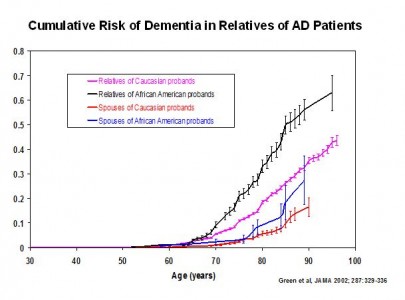MIRAGE Study
The MIRAGE (Multi Institutional Research of Alzheimer Genetic Epidemiology) Study, funded by the National Institute on Aging since 1991, is the largest genetic epidemiology study of AD in the world. We have collected detailed clinical, risk factor and family history information on more than 2,500 rigorously examined AD patients. Analyses of these data and DNA from a large portion of these families has resulted in more than 50 original research papers focusing on a variety of genetic and non-genetic factors including head trauma, alcohol consumption, smoking, depression, use of various medications (e.g., non-steroidal inflammatory drugs, statins, estrogen), and parental age.1-7 Genetic modeling and survival analysis studies revealed that the common form of AD which appears typically after age 65 is neither inevitable nor a Mendelian disease, but still highly heritable with at least one genes having a major influence on susceptibility.8,9 We know now that one of these genes is APOE. The discovery in 1993 that the ɛ4 variant of APOE is associated with AD in a dose-dependent fashion has been confirmed in dozens of studies of populations from many parts of the world. However, the MIRAGE Study revealed that ɛ4 is more weakly associated with disease in men and persons older than 75 years.10 The MIRAGE Study has also assembled the largest collection of African American families for AD research. Initial studies of these families have shown that first-degree biological relatives of African Americans with AD have a higher life time risk of dementia than do relatives of Whites with AD.11 However, the additional risk of dementia conferred by being a biological relative or by being female is similar in African American and White families. Our studies of the AD/ε4 association in African Americans provided for the first time clear evidence that APOE genotype influences AD risk in an age-dependent fashion similar to non-Hispanic Whites.12 The MIRAGE Study has also evaluated association with many candidate genes in a hypothesis-driven approach. This approach lead to the discovery of association between multiple SNPs across the paraoxonase (PON) gene cluster including ethnic-specific patterns, and that expression of these genes in serum is associated with AD risk.13,14
- Guo Z, Cupples LA, Kurz A, Auerbach SH, Volicer L, Chui H, Green RC, Sadovnick AD, Duara R, DeCarli C, Johnson K, Go RC, Growdon JH, Kukull WA, Farrer LA. Head injury and the risk of Alzheimer disease in the MIRAGE Study. Neurology 2000; 54:1316-1323. PMID: 10746604 http://www.neurology.org/content/54/6/1316.long
- Cupples LA, Weinberg J, Beiser A, Auerbach SH, Volicer L, Cipolloni PB, Wells J, Growdon JH, D’Agostino R, Wolf PA, Farrer LA. Effects of smoking, alcohol and APOE genotype on Alzheimer disease: The MIRAGE Study. Alzheimers Reports 2000; 3:105-113.
- Green RC, Cupples LA, Kurz, Auerbach S, Go R, Sadovnick D, Duara R, DeCarli C, Kukull W, Chui H, Edeki T, Griffith P, Friedland RP, Bachman D, Farrer LA. Depression as a risk factor for Alzheimer disease: the MIRAGE Study. Arch Neurol 2003; 60:753-759. PMID: 12756140 http://archneur.jamanetwork.com/article.aspx?articleid=784148
- Henderson VW, Benke KS, Green RC, Cupples LA, Farrer LA, for the MIRAGE Study Group. Postmenopausal estrogen therapy and Alzheimer disease risk: interaction with age. J Neurol Neurosurg Psychiatry 2005; 76:103-105. PMID: 15608005 http://www.ncbi.nlm.nih.gov/pmc/articles/PMC1739309/
- Yip AG, Green RC, Huyck M, Cupples LA, Farrer LA, for the MIRAGE Study Group. Nonsteroidal anti-inflammatory drug use and Alzheimer disease risk: The MIRAGE Study. Biomed Central Geriatrics 2005; 5:2. PMID: 15647106 http://www.ncbi.nlm.nih.gov/pmc/articles/PMC546007/
- Green RC, McNagny SE, Jayakumar P, Cupples LA, Farrer LA, for the MIRAGE Study Group. Statin use is associated with lower risk of Alzheimer disease: The MIRAGE Study. Alz Dementia 2006; 2:96-103. PMID: 19595865 http://www.sciencedirect.com/science/article/pii/S1552526006000434
- Farrer LA, Cupples LA, Kukull WA, Volicer L, Wells JM, Kurz A, Green RC, Chui H, Duara R, Auerbach SA, Larson E, Lautenschlager N, Wolf PA, D’Agostino R, Ordovas J, Schaefer E, Growdon JH, Haines JL. Risk of Alzheimer disease is associated with parental age among apolipoprotein E ε4 heterozygotes. Alzheimer’s Research 1997; 3:83-91.
- Farrer LA, Myers RH, Connor L, Cupples LA, Growdon JH. Segregation analysis reveals evidence of a major gene for Alzheimer disease. Am J Hum Genet 1991; 48:1026-1033. PMID: 2035523 http://www.ncbi.nlm.nih.gov/pmc/articles/PMC1683119/
- Rao VS, Cupples LA, van Duijn CM, Kurz A, Green RC, Chui H, Duara R, Auerbach SA, Volicer L, Wells J, van Broeckhoven C, Growdon JH, Haines JL, Farrer LA. Evidence for major gene inheritance of Alzheimer disease in families of patients with and without Apoe ε4. Am J Hum Genet 1996;59:664-675. PMID: 8751868 http://www.ncbi.nlm.nih.gov/pmc/articles/PMC1914898/
- Farrer LA, Cupples LA, Haines JL, Hyman BT, Kukull WA, Mayeux R, Pericak-Vance MA, Risch N, van Duijn CM for the APOE and Alzheimer Disease Meta Analysis Consortium. Effects of age, gender and ethnicity on the association of apolipoprotein E genotype and Alzheimer disease. JAMA 1997; 278: 1349-1356. PMID: 9343467 http://www.ncbi.nlm.nih.gov/pubmed/9343467
- Green RC, Cupples LA, Go RCPG, Benke KS, Edeki T, Griffith PA, Williams M, Hipps Y, Graff-Radford N, Bachman D, Farrer LA, for the MIRAGE Study Group. Risk of dementia among white and African American relatives of patients with Alzheimer’s disease. JAMA 2002; 287:329-336. PMID: 11790212 http://jama.jamanetwork.com/article.aspx?articleid=194571
- Graff-Radford N, Green RC, Go RCPG, Hutton ML, Edeki T, Bachman D, Adamson JL, Griffith P, Willis FB, Williams M, Hipps Y, Haines JL, Cupples LA, Farrer LA. Association between APOE genotype and Alzheimer disease in African Americans. Arch Neurol 2002; 59:594-600. PMID: 11939894 http://archneur.jamanetwork.com/article.aspx?articleid=781778
- Erlich PM, Lunetta KL, Cupples LA, Huyck M, Green RC, Baldwin CT, Farrer LA. Polymorphisms in the PON gene cluster are associated with Alzheimer disease. Hum Mol Genet 2006; 15:77-85. PMID: 16319130 http://hmg.oxfordjournals.org/content/15/1/77.long
- Erlich PM, Lunetta KL, Cupples, LA, Abraham CR, Green RC, Baldwin CT, Farrer LA. Measures of serum paraoxonase activity are associated with multiple distinct variants in the PON gene cluster and risk of Alzheimer disease. Neurobiol Aging 2012; 33:1015. PMID: 20980077. http://www.sciencedirect.com/science/article/pii/S0197458010003519
